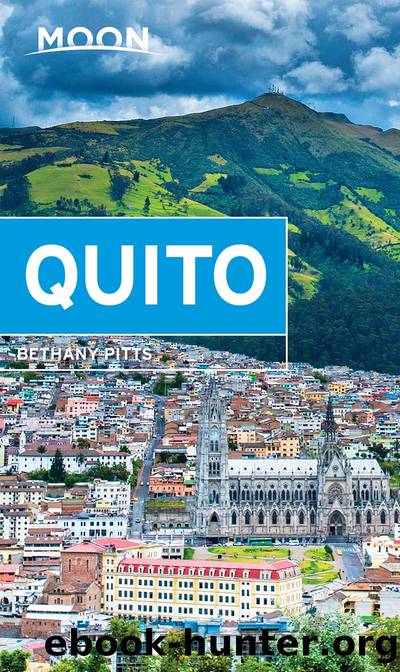Moon Quito by Bethany Pitts

Author:Bethany Pitts
Language: eng
Format: epub
Publisher: Avalon Publishing
Published: 2019-07-15T00:00:00+00:00
Plants and Animals
Ecuador is the ninth most biodiverse country in the world. Measured per unit area, it’s the most biodiverse. Covering less than 0.005 percent of the planet’s surface, it boasts 10 percent of all plant species on earth (almost 20,000, more than in all of North America) and one-sixth of all birds (more than 1,600 species, compared with 844 in North America).
Ecuador is one of the best countries in the world for bird-watching. Of the myriad species, perhaps the hummingbird (colibrí) deserves special mention, for its presence in all of the mainland regions. They are even spotted buzzing around in Quito. Ecuador is home to over 132 hummingbird species, almost half of the world’s total, including the world’s second smallest, the estrellita Esmeraldeña (or Esmeraldas woodstar). Also of note is the sword-billed hummingbird, which totes a 10-centimeter (4-in) beak.
In the Sierra, the valley interiors were once covered with a thorny woodland, giving way to a low evergreen forest toward the valley edges, then to the grasslands of the páramo at higher elevations. The foothills are now mostly covered with a rolling tapestry of agricultural fields, which, sadly, have become more quintessentially Ecuadorian than the forests they replaced.
Situated between the tree line and the snow line at an elevation of 3,000-5,000 meters (9,800-16,500 ft), the windswept grasslands of the páramo rise to rocky mountains interspersed with crystalline lakes and streams. Acting as giant sponges, these moorlands give birth to a number of Ecuador’s rivers and provide water for many Sierran towns and communities. Much of the páramo is sprinkled with wildflowers, but at very high elevations few flowers can survive. A notable exception is the orange thistle-like chuquiraga, regarded as the national flower. Another iconic plant is the frailejón, a spiky-headed relative of the sunflower that, despite only growing one centimeter every year, can reach several meters in height. Impressive páramos can be found near Otavalo in the northern Sierra and in the Cotopaxi National Park in the central Sierra.
The most famous avian resident of the páramo is the Andean condor, the world’s largest flying bird, with a wingspan of more than 3 meters (10 ft) and weighing up to 15 kilograms (33 lb). The condor is Ecuador’s national bird and a symbol of Andean identity. A type of vulture, it is critically endangered, with between 50 and 100 mating pairs in the country. Cotopaxi National Park is the best place to see the carunculated caracara, the largest member of the falcon family, with its bright red face, yellow bill, and black body. Locally known as a curiquingue, the caracara was a sacred bird for the Inca.
The mammalian star of the show is the highly endangered Andean spectacled bear, named for white patches around its eyes. The only bear native to South America, the oso andino can be found in the cloud forest as well as the páramo. The males can reach 2 meters (6.5 ft) in length.
South America’s high-elevation relatives of the camel—llamas, vicuñas, and alpacas—were hunted to extinction,
Download
This site does not store any files on its server. We only index and link to content provided by other sites. Please contact the content providers to delete copyright contents if any and email us, we'll remove relevant links or contents immediately.
Annapurna by Maurice Herzog(3446)
Liar's Poker by Michael Lewis(3413)
A Forest Journey by John Perlin(3042)
Atlas Obscura by Joshua Foer(2931)
The Ogre by Doug Scott(2657)
Cuba by Lonely Planet(2599)
Photographic Guide to the Birds of Indonesia by Strange Morten;(2509)
The Splendid and the Vile by Erik Larson(2415)
Tokyo by Rob Goss(2405)
All Things Reconsidered by Bill Thompson III(2370)
Fatal Storm by Rob Mundle(2193)
A TIME OF GIFTS by Patrick Leigh Fermor(2173)
INTO THE WILD by Jon Krakauer(2170)
DK Eyewitness Top 10 Travel Guides Orlando by DK(2150)
Trail Magic by Trevelyan Quest Edwards & Hazel Edwards(2143)
Touching the Void by Joe Simpson(2106)
Top 10 Dubai and Abu Dhabi by DK Travel(2074)
Abbey in America by Murray John A(2062)
Lonely Planet Australia by Lonely Planet(2052)
